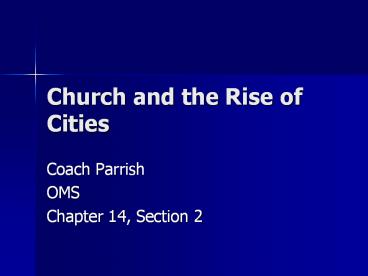Church and the Rise of Cities - PowerPoint PPT Presentation
Title:
Church and the Rise of Cities
Description:
Church and the Rise of Cities Coach Parrish OMS Chapter 14, Section 2 * * * * * * Church in the Middle Ages Most gothic cathedrals were built between 1100 1400 AD. – PowerPoint PPT presentation
Number of Views:172
Avg rating:3.0/5.0
Title: Church and the Rise of Cities
1
Church and the Rise of Cities
- Coach Parrish
- OMS
- Chapter 14, Section 2
2
Church in the Middle Ages
- Most gothic cathedrals were built between 1100
1400 AD. Gothic is a style of architecture.
Most people in western Europe were Roman
Catholic. - The Church was powerful for the reasons on the
following slides.
3
Reims Cathedral - France
4
Reims Cathedral - Interior
5
Religious and Economic Power
- People followed the Church. Why?
- Promise of Rewards
- Threat of Punishment
- The Church gained great wealth by charging taxes.
The Church took fiefs in exchange for religious
services performed by clergy persons authorized
to perform religious services.
6
Political Power of the Church
- The Church set up laws and put together courts to
enforce them. People who did not obey were
threatened with excommunication - expelled from
membership in the Church. - High Church officials were advisors to kings and
lords. The Church used its power to limit
warfare.
7
Church Organization
- The Church was highly organized. Almost every
village had a priest. A bishop supervised
several priests. An archbishop supervised
several bishops. - The archbishops answered to the Pope. The
papacy, or government of the Church, was based in
Rome.
8
Church in Everyday Life
- The Medieval Church touched nearly all aspects of
life. During the Middle Ages, the clergy were
almost always in attendance to offer a blessing
or to perform a service. - The clergy listened when people confessed their
sins and forgave them.
9
Monasteries and Convents
- Monasteries were communities where men who had
dedicated their life to God lived together.
Women who had dedicated their lives to God lived
in convents. - Men were called monks and women nuns. They were
better educated than most and invented new ways
of growing crops.
10
Scholasticism
- Scholasticism used reason to support Christian
beliefs. The Church asked that people believe
things on faith even though some had taken up
Greek reason. - Scholasticism was a method to try and eliminate
contradictions between the Church and philosophy.
11
Early school practicing scholasticism
12
Growth of Towns
- As trade increased, villages turned into larger
trading towns. Traders gathered at convenient
locations to help their sales. - Manors were becoming overcrowded, and lords
encouraged peasants to move to the growing towns.
13
Trading Routes
14
Rise of Middle Class
- Town life was far different than manor life.
Towns existed because of the exchange of goods
and services. - A new class of people developed, made up of
merchants, traders, and craft people. They
became the middle class.
15
Role of Guilds
- In many towns, the middle class formed guilds
medieval organization of crafts, workers, and
merchants. Example Shoemaker guild - Guilds set prices and prevented people from
outside the town to sell their goods. Guild
members paid dues which went for needy members or
loved ones who died.
16
Role of Guilds, cont.
- Joining a guild took time. Between the ages of 8
and 14, a boy who wanted to learn a certain job
became an apprentice unpaid worker being
trained. - He lived with a training master for up to 7
years. He then became a journeyman, or salaried
worker. After time, he could join the guild.
17
Guild Coat of Arms
18
Overcrowding and Disease
- Medieval towns and cities were extremely
overcrowded. The lack of sanitation caused
diseases that spread very quickly. One disease,
the bubonic plague, wiped out 1/3 of Europes
population in just 4 years. - Called the Black Death, it was spread by fleas
living on rats.
19
Medieval Culture
- Chivalry code of honorable conduct by which
knights were supposed to live. - Troubadours traveling poets and musicians.
They went around singing about brave missions
performed by knights.
20
Troubadours































